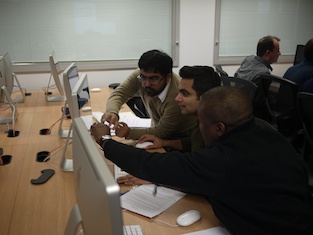Training from the Back of the Room
A while ago I read Sharon Bowman’s book Training from the Back of the Room. In the book, Bowman presents a number of techniques for getting away from the traditional “chalk and talk” form of training, and making learning a more interactive experience. She suggests connecting with previous experiences, cutting down the length of presented segments, focussing on concrete practice and exercises, and putting the learners at the centre of the activity - rather than being a passive audience.
I have been trying to add more of these elements to my training and educational work. I try to have a balance of about one third presentation to two thirds hands-on practical exercises.
Last week I taught my Agile Engineering Practices course, part of Oxford University’s Software Engineering MSc, which is an intensive 1-week format. It’s an in-depth look at the engineering practices that support the application agile methods to software development, and we cover a lot of different types of tools and how they support one another.
One things we did differently this time was to have each student research a different tool in their own time and make a short presentation (5 minutes or so) or demo describing the tool, what it was for, comparisons with any alternatives etc. This seemed to be a good way of getting the students involved in presenting some of the material, and widening the landscape of tools that we could cover in the course. The students did a good job of the presentations, and I also noted that these short talks generated a lot of questions from the rest of the class, more so than the longer sections of material that I presented.


For the hands-on exercises, we encourage people to pair, but it isn’t always taken up. People say they want to make sure they understand things themselves, rather than relying on their pair to solve the exercise. Some pairs are sticky, as people tend to work on the same computers from day to day. Perhaps we should do more to enforce rotation. Perhaps we might try to match (or rather mis-match) experience with a particular tool or technology in the pairs, so that someone who is more familiar can teach someone who has less experience.


Given the advice in the book on making learning more effective, I think I’d like to try using these sort of techniques for more of the course, but it is quite at odds with the normal university style of teaching. The students expect to be lectured to, and particularly for undergraduates, do not really appear to think of other forms of teaching as as efficient or effective. Tutorials are often attended much less than lectures. In Oxford we have the benefit that the whole class attends all the sessions for the whole week, so there might be more opportunities to innovate on the format.

